Samsung's Organizational Culture: Korea vs Australia
VerifiedAdded on 2021/05/31
|8
|1668
|43
Report
AI Summary
This report offers an analysis of Samsung's organizational culture, comparing its practices in Korea and Australia. The report begins by establishing the significance of organizational culture and its impact on a company's operations, especially in a globalized context. It then delves into the specific cultural dimensions of Samsung, applying Hofstede's framework to understand the nuances of its operations in both countries. The Korean branch is characterized by a traditional, hierarchical structure emphasizing seniority and loyalty, while the Australian branch demonstrates a flatter structure with more emphasis on employee independence and goal orientation. The report concludes with recommendations for Samsung to adapt its organizational culture to align with local cultural norms in both regions. This includes suggestions for the Korean branch to move away from a strict seniority-based system and for the Australian branch to provide greater employee independence. The report emphasizes the importance of adapting to local cultural norms to ensure effective business operations.
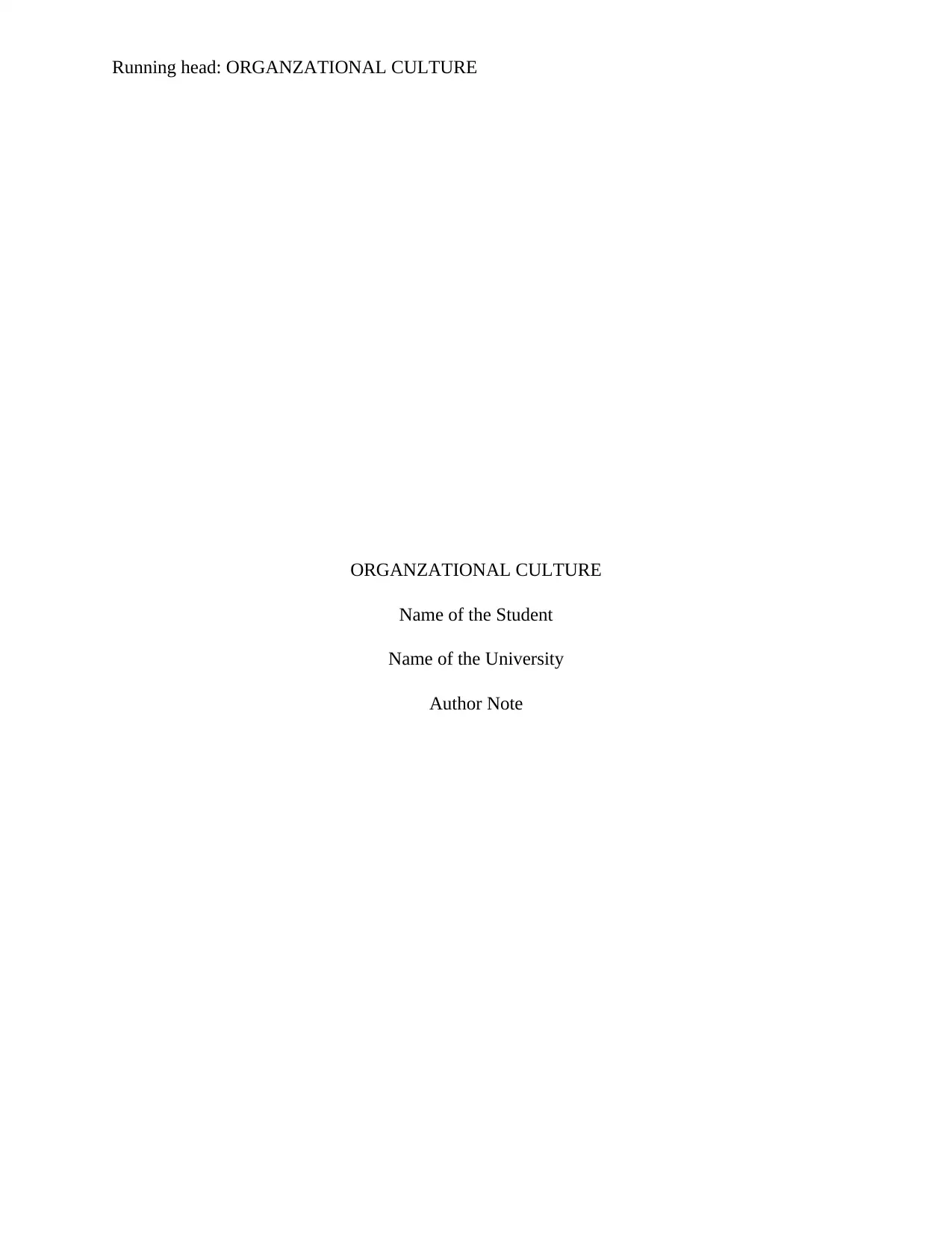
Running head: ORGANZATIONAL CULTURE
ORGANZATIONAL CULTURE
Name of the Student
Name of the University
Author Note
ORGANZATIONAL CULTURE
Name of the Student
Name of the University
Author Note
Paraphrase This Document
Need a fresh take? Get an instant paraphrase of this document with our AI Paraphraser
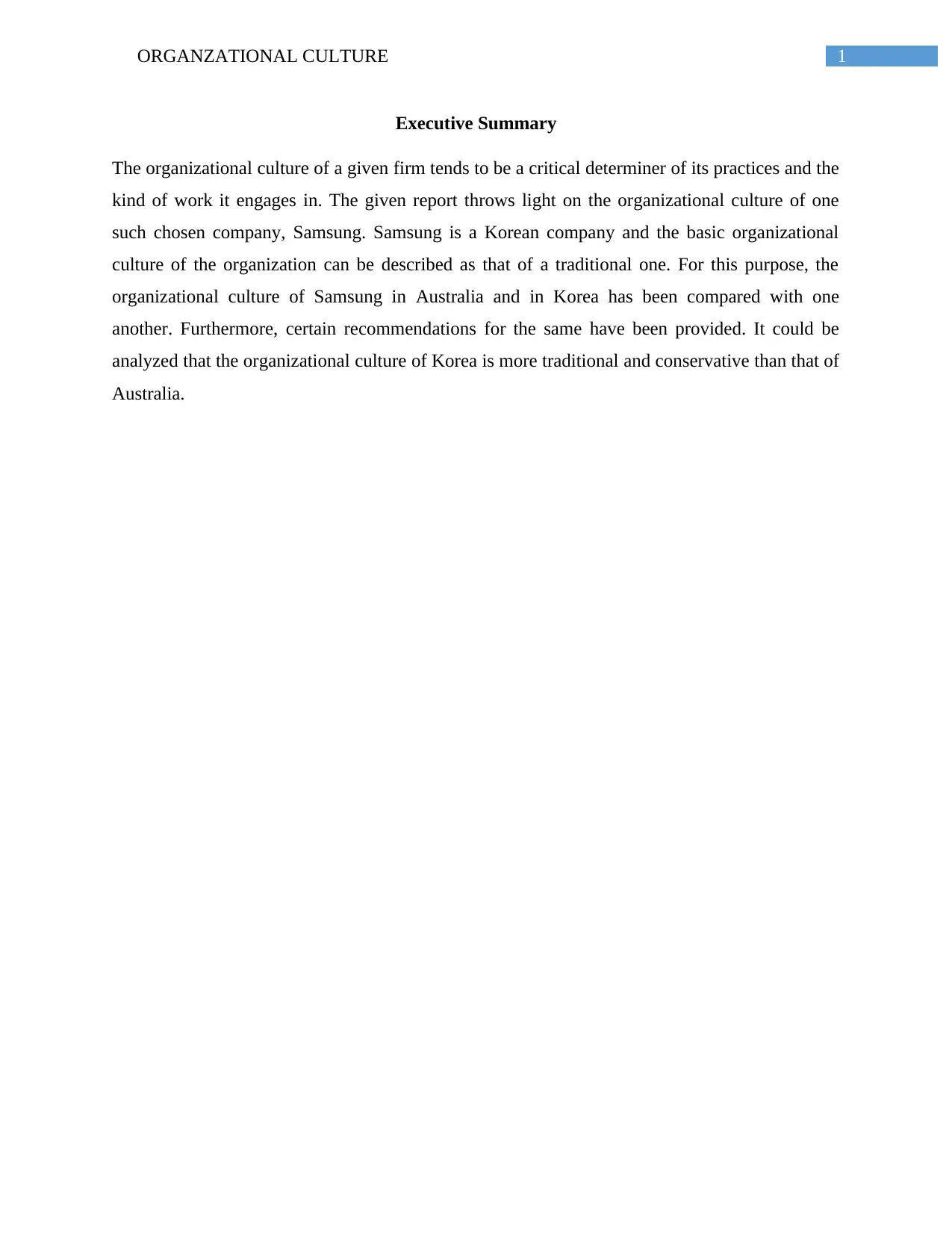
1ORGANZATIONAL CULTURE
Executive Summary
The organizational culture of a given firm tends to be a critical determiner of its practices and the
kind of work it engages in. The given report throws light on the organizational culture of one
such chosen company, Samsung. Samsung is a Korean company and the basic organizational
culture of the organization can be described as that of a traditional one. For this purpose, the
organizational culture of Samsung in Australia and in Korea has been compared with one
another. Furthermore, certain recommendations for the same have been provided. It could be
analyzed that the organizational culture of Korea is more traditional and conservative than that of
Australia.
Executive Summary
The organizational culture of a given firm tends to be a critical determiner of its practices and the
kind of work it engages in. The given report throws light on the organizational culture of one
such chosen company, Samsung. Samsung is a Korean company and the basic organizational
culture of the organization can be described as that of a traditional one. For this purpose, the
organizational culture of Samsung in Australia and in Korea has been compared with one
another. Furthermore, certain recommendations for the same have been provided. It could be
analyzed that the organizational culture of Korea is more traditional and conservative than that of
Australia.
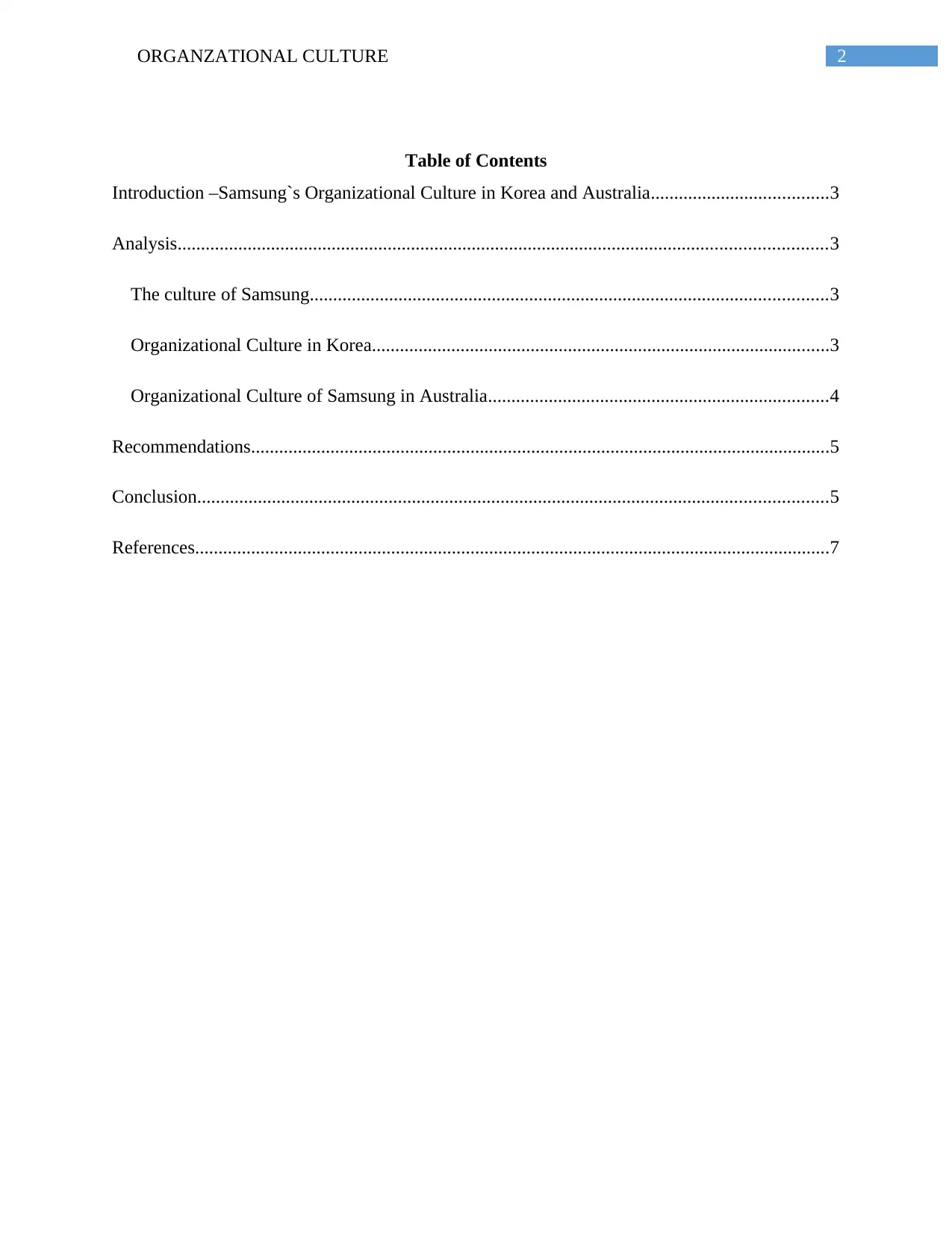
2ORGANZATIONAL CULTURE
Table of Contents
Introduction –Samsung`s Organizational Culture in Korea and Australia......................................3
Analysis...........................................................................................................................................3
The culture of Samsung...............................................................................................................3
Organizational Culture in Korea..................................................................................................3
Organizational Culture of Samsung in Australia.........................................................................4
Recommendations............................................................................................................................5
Conclusion.......................................................................................................................................5
References........................................................................................................................................7
Table of Contents
Introduction –Samsung`s Organizational Culture in Korea and Australia......................................3
Analysis...........................................................................................................................................3
The culture of Samsung...............................................................................................................3
Organizational Culture in Korea..................................................................................................3
Organizational Culture of Samsung in Australia.........................................................................4
Recommendations............................................................................................................................5
Conclusion.......................................................................................................................................5
References........................................................................................................................................7
⊘ This is a preview!⊘
Do you want full access?
Subscribe today to unlock all pages.

Trusted by 1+ million students worldwide
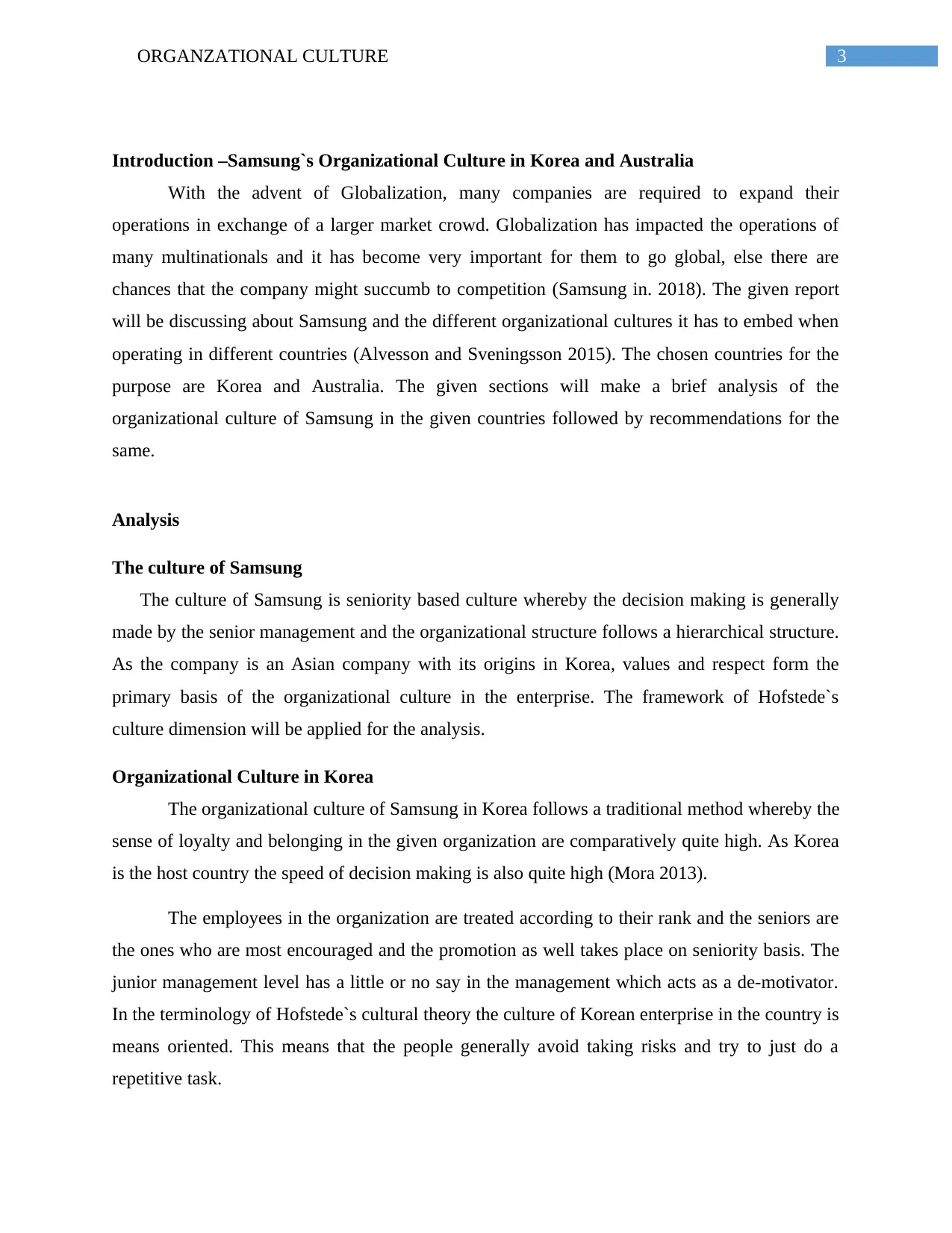
3ORGANZATIONAL CULTURE
Introduction –Samsung`s Organizational Culture in Korea and Australia
With the advent of Globalization, many companies are required to expand their
operations in exchange of a larger market crowd. Globalization has impacted the operations of
many multinationals and it has become very important for them to go global, else there are
chances that the company might succumb to competition (Samsung in. 2018). The given report
will be discussing about Samsung and the different organizational cultures it has to embed when
operating in different countries (Alvesson and Sveningsson 2015). The chosen countries for the
purpose are Korea and Australia. The given sections will make a brief analysis of the
organizational culture of Samsung in the given countries followed by recommendations for the
same.
Analysis
The culture of Samsung
The culture of Samsung is seniority based culture whereby the decision making is generally
made by the senior management and the organizational structure follows a hierarchical structure.
As the company is an Asian company with its origins in Korea, values and respect form the
primary basis of the organizational culture in the enterprise. The framework of Hofstede`s
culture dimension will be applied for the analysis.
Organizational Culture in Korea
The organizational culture of Samsung in Korea follows a traditional method whereby the
sense of loyalty and belonging in the given organization are comparatively quite high. As Korea
is the host country the speed of decision making is also quite high (Mora 2013).
The employees in the organization are treated according to their rank and the seniors are
the ones who are most encouraged and the promotion as well takes place on seniority basis. The
junior management level has a little or no say in the management which acts as a de-motivator.
In the terminology of Hofstede`s cultural theory the culture of Korean enterprise in the country is
means oriented. This means that the people generally avoid taking risks and try to just do a
repetitive task.
Introduction –Samsung`s Organizational Culture in Korea and Australia
With the advent of Globalization, many companies are required to expand their
operations in exchange of a larger market crowd. Globalization has impacted the operations of
many multinationals and it has become very important for them to go global, else there are
chances that the company might succumb to competition (Samsung in. 2018). The given report
will be discussing about Samsung and the different organizational cultures it has to embed when
operating in different countries (Alvesson and Sveningsson 2015). The chosen countries for the
purpose are Korea and Australia. The given sections will make a brief analysis of the
organizational culture of Samsung in the given countries followed by recommendations for the
same.
Analysis
The culture of Samsung
The culture of Samsung is seniority based culture whereby the decision making is generally
made by the senior management and the organizational structure follows a hierarchical structure.
As the company is an Asian company with its origins in Korea, values and respect form the
primary basis of the organizational culture in the enterprise. The framework of Hofstede`s
culture dimension will be applied for the analysis.
Organizational Culture in Korea
The organizational culture of Samsung in Korea follows a traditional method whereby the
sense of loyalty and belonging in the given organization are comparatively quite high. As Korea
is the host country the speed of decision making is also quite high (Mora 2013).
The employees in the organization are treated according to their rank and the seniors are
the ones who are most encouraged and the promotion as well takes place on seniority basis. The
junior management level has a little or no say in the management which acts as a de-motivator.
In the terminology of Hofstede`s cultural theory the culture of Korean enterprise in the country is
means oriented. This means that the people generally avoid taking risks and try to just do a
repetitive task.
Paraphrase This Document
Need a fresh take? Get an instant paraphrase of this document with our AI Paraphraser
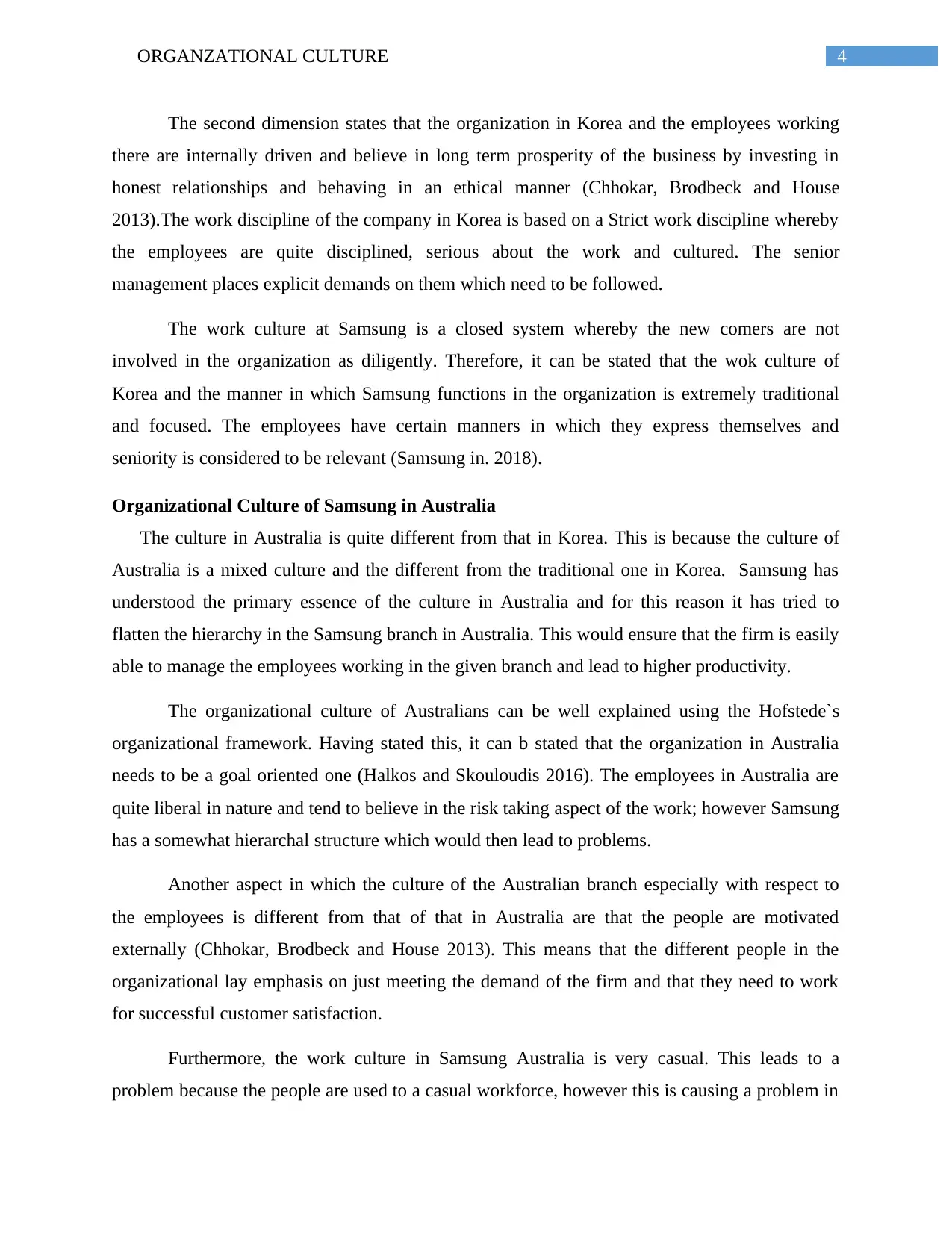
4ORGANZATIONAL CULTURE
The second dimension states that the organization in Korea and the employees working
there are internally driven and believe in long term prosperity of the business by investing in
honest relationships and behaving in an ethical manner (Chhokar, Brodbeck and House
2013).The work discipline of the company in Korea is based on a Strict work discipline whereby
the employees are quite disciplined, serious about the work and cultured. The senior
management places explicit demands on them which need to be followed.
The work culture at Samsung is a closed system whereby the new comers are not
involved in the organization as diligently. Therefore, it can be stated that the wok culture of
Korea and the manner in which Samsung functions in the organization is extremely traditional
and focused. The employees have certain manners in which they express themselves and
seniority is considered to be relevant (Samsung in. 2018).
Organizational Culture of Samsung in Australia
The culture in Australia is quite different from that in Korea. This is because the culture of
Australia is a mixed culture and the different from the traditional one in Korea. Samsung has
understood the primary essence of the culture in Australia and for this reason it has tried to
flatten the hierarchy in the Samsung branch in Australia. This would ensure that the firm is easily
able to manage the employees working in the given branch and lead to higher productivity.
The organizational culture of Australians can be well explained using the Hofstede`s
organizational framework. Having stated this, it can b stated that the organization in Australia
needs to be a goal oriented one (Halkos and Skouloudis 2016). The employees in Australia are
quite liberal in nature and tend to believe in the risk taking aspect of the work; however Samsung
has a somewhat hierarchal structure which would then lead to problems.
Another aspect in which the culture of the Australian branch especially with respect to
the employees is different from that of that in Australia are that the people are motivated
externally (Chhokar, Brodbeck and House 2013). This means that the different people in the
organizational lay emphasis on just meeting the demand of the firm and that they need to work
for successful customer satisfaction.
Furthermore, the work culture in Samsung Australia is very casual. This leads to a
problem because the people are used to a casual workforce, however this is causing a problem in
The second dimension states that the organization in Korea and the employees working
there are internally driven and believe in long term prosperity of the business by investing in
honest relationships and behaving in an ethical manner (Chhokar, Brodbeck and House
2013).The work discipline of the company in Korea is based on a Strict work discipline whereby
the employees are quite disciplined, serious about the work and cultured. The senior
management places explicit demands on them which need to be followed.
The work culture at Samsung is a closed system whereby the new comers are not
involved in the organization as diligently. Therefore, it can be stated that the wok culture of
Korea and the manner in which Samsung functions in the organization is extremely traditional
and focused. The employees have certain manners in which they express themselves and
seniority is considered to be relevant (Samsung in. 2018).
Organizational Culture of Samsung in Australia
The culture in Australia is quite different from that in Korea. This is because the culture of
Australia is a mixed culture and the different from the traditional one in Korea. Samsung has
understood the primary essence of the culture in Australia and for this reason it has tried to
flatten the hierarchy in the Samsung branch in Australia. This would ensure that the firm is easily
able to manage the employees working in the given branch and lead to higher productivity.
The organizational culture of Australians can be well explained using the Hofstede`s
organizational framework. Having stated this, it can b stated that the organization in Australia
needs to be a goal oriented one (Halkos and Skouloudis 2016). The employees in Australia are
quite liberal in nature and tend to believe in the risk taking aspect of the work; however Samsung
has a somewhat hierarchal structure which would then lead to problems.
Another aspect in which the culture of the Australian branch especially with respect to
the employees is different from that of that in Australia are that the people are motivated
externally (Chhokar, Brodbeck and House 2013). This means that the different people in the
organizational lay emphasis on just meeting the demand of the firm and that they need to work
for successful customer satisfaction.
Furthermore, the work culture in Samsung Australia is very casual. This leads to a
problem because the people are used to a casual workforce, however this is causing a problem in

5ORGANZATIONAL CULTURE
the Australian branch as the different people are not used to a disciplinary culture which the firm
tries to enforce. The managers try and incorporate convenience as much as possible. Briefly
stated, the culture of Australia is very free and independent.
Recommendations
After analyzing the culture of the company Samsung in Korea and in Australia is quite
different from one another. The organization in Australia has a flatter format as compared to the
format in Korea which is strictly based on well set and defined hierarchical based structure. For
this purpose, it is extremely important for the given organization to ensure that there does not
take place any discrepancy and people are given freedom to work in the given organization (Hsu,
Woodside and Marshall 2013).
The Samsung Korea firm needs to incorporate a culture that devoid the organization from
it usual path of seniority based system (Bãlan and Vreja 2013). The seniority based
promotions and facilities which are provided in the organization tend to act as a huge de-
motivator and spoil the culture of the given firm.
The organization in Australia is following a flat structure however, it needs to provide
with more independence to adhere to the needs of the employees who belong to a much
liberal culture (Baltador, Budac and Belascu 2013).
Conclusion
Therefore, from the given analysis it can be witnessed that the organization culture and
the structure re huge determiners if the way an organization is functioned. Although the Samsung
organization is a Korean company, it has expanded its operations in the other parts of the world.
The organizational culture in Korea is more disciplinary and based on specified norms and
traditions whereby the seniors are given more importance. Whereas the organizational culture in
Australia is more liberal and based on merit-oriented promotion and importance.
As the company has a traditional format in nature, its traces can be felt in the manner the
Australian branch is functioned. This needs to be changed as the organization needs to adapt with
changes and see to it that the country operates as per the local cultural. Hence, if the culture of
the Australian branch as the different people are not used to a disciplinary culture which the firm
tries to enforce. The managers try and incorporate convenience as much as possible. Briefly
stated, the culture of Australia is very free and independent.
Recommendations
After analyzing the culture of the company Samsung in Korea and in Australia is quite
different from one another. The organization in Australia has a flatter format as compared to the
format in Korea which is strictly based on well set and defined hierarchical based structure. For
this purpose, it is extremely important for the given organization to ensure that there does not
take place any discrepancy and people are given freedom to work in the given organization (Hsu,
Woodside and Marshall 2013).
The Samsung Korea firm needs to incorporate a culture that devoid the organization from
it usual path of seniority based system (Bãlan and Vreja 2013). The seniority based
promotions and facilities which are provided in the organization tend to act as a huge de-
motivator and spoil the culture of the given firm.
The organization in Australia is following a flat structure however, it needs to provide
with more independence to adhere to the needs of the employees who belong to a much
liberal culture (Baltador, Budac and Belascu 2013).
Conclusion
Therefore, from the given analysis it can be witnessed that the organization culture and
the structure re huge determiners if the way an organization is functioned. Although the Samsung
organization is a Korean company, it has expanded its operations in the other parts of the world.
The organizational culture in Korea is more disciplinary and based on specified norms and
traditions whereby the seniors are given more importance. Whereas the organizational culture in
Australia is more liberal and based on merit-oriented promotion and importance.
As the company has a traditional format in nature, its traces can be felt in the manner the
Australian branch is functioned. This needs to be changed as the organization needs to adapt with
changes and see to it that the country operates as per the local cultural. Hence, if the culture of
⊘ This is a preview!⊘
Do you want full access?
Subscribe today to unlock all pages.

Trusted by 1+ million students worldwide
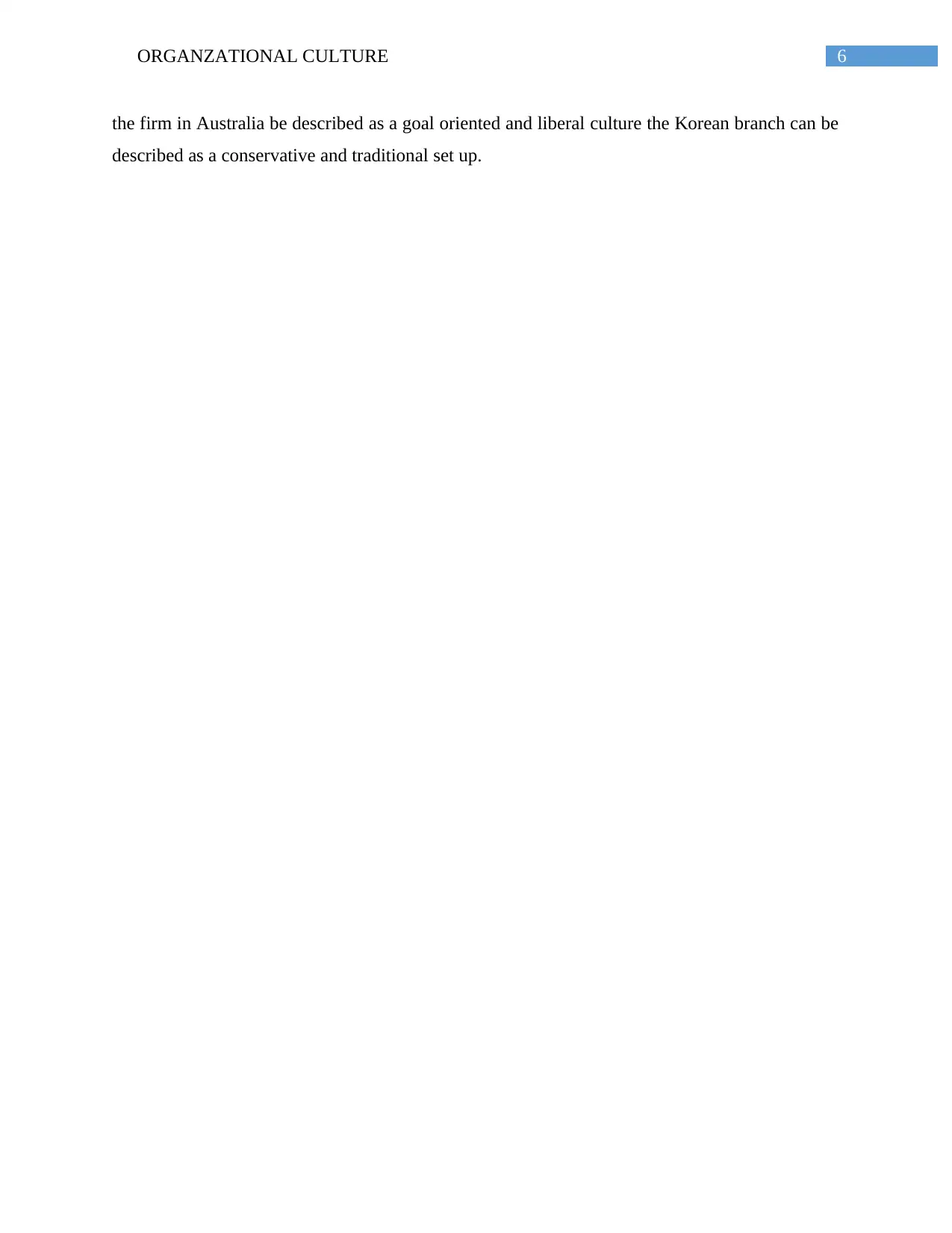
6ORGANZATIONAL CULTURE
the firm in Australia be described as a goal oriented and liberal culture the Korean branch can be
described as a conservative and traditional set up.
the firm in Australia be described as a goal oriented and liberal culture the Korean branch can be
described as a conservative and traditional set up.
Paraphrase This Document
Need a fresh take? Get an instant paraphrase of this document with our AI Paraphraser
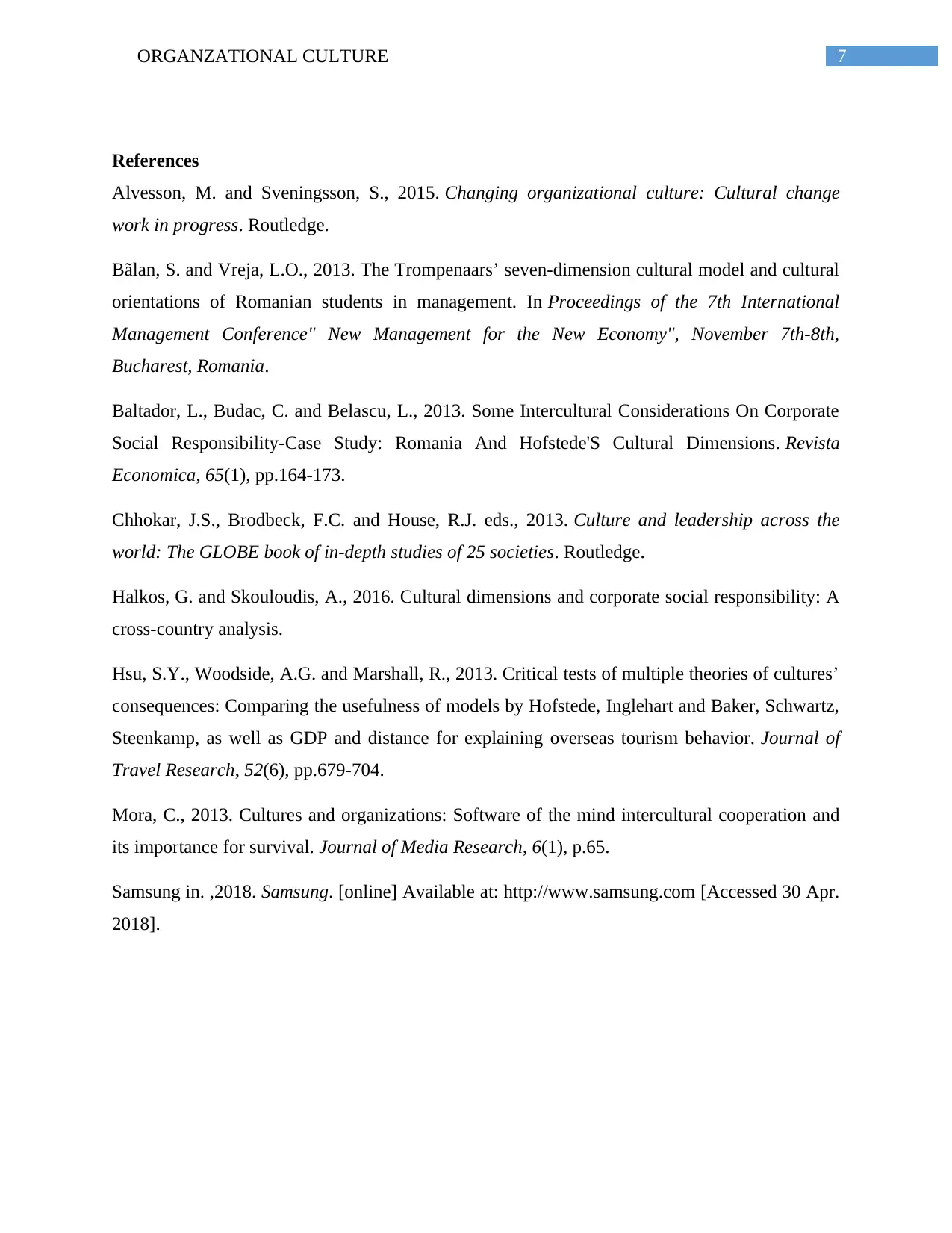
7ORGANZATIONAL CULTURE
References
Alvesson, M. and Sveningsson, S., 2015. Changing organizational culture: Cultural change
work in progress. Routledge.
Bãlan, S. and Vreja, L.O., 2013. The Trompenaars’ seven-dimension cultural model and cultural
orientations of Romanian students in management. In Proceedings of the 7th International
Management Conference" New Management for the New Economy", November 7th-8th,
Bucharest, Romania.
Baltador, L., Budac, C. and Belascu, L., 2013. Some Intercultural Considerations On Corporate
Social Responsibility-Case Study: Romania And Hofstede'S Cultural Dimensions. Revista
Economica, 65(1), pp.164-173.
Chhokar, J.S., Brodbeck, F.C. and House, R.J. eds., 2013. Culture and leadership across the
world: The GLOBE book of in-depth studies of 25 societies. Routledge.
Halkos, G. and Skouloudis, A., 2016. Cultural dimensions and corporate social responsibility: A
cross-country analysis.
Hsu, S.Y., Woodside, A.G. and Marshall, R., 2013. Critical tests of multiple theories of cultures’
consequences: Comparing the usefulness of models by Hofstede, Inglehart and Baker, Schwartz,
Steenkamp, as well as GDP and distance for explaining overseas tourism behavior. Journal of
Travel Research, 52(6), pp.679-704.
Mora, C., 2013. Cultures and organizations: Software of the mind intercultural cooperation and
its importance for survival. Journal of Media Research, 6(1), p.65.
Samsung in. ,2018. Samsung. [online] Available at: http://www.samsung.com [Accessed 30 Apr.
2018].
References
Alvesson, M. and Sveningsson, S., 2015. Changing organizational culture: Cultural change
work in progress. Routledge.
Bãlan, S. and Vreja, L.O., 2013. The Trompenaars’ seven-dimension cultural model and cultural
orientations of Romanian students in management. In Proceedings of the 7th International
Management Conference" New Management for the New Economy", November 7th-8th,
Bucharest, Romania.
Baltador, L., Budac, C. and Belascu, L., 2013. Some Intercultural Considerations On Corporate
Social Responsibility-Case Study: Romania And Hofstede'S Cultural Dimensions. Revista
Economica, 65(1), pp.164-173.
Chhokar, J.S., Brodbeck, F.C. and House, R.J. eds., 2013. Culture and leadership across the
world: The GLOBE book of in-depth studies of 25 societies. Routledge.
Halkos, G. and Skouloudis, A., 2016. Cultural dimensions and corporate social responsibility: A
cross-country analysis.
Hsu, S.Y., Woodside, A.G. and Marshall, R., 2013. Critical tests of multiple theories of cultures’
consequences: Comparing the usefulness of models by Hofstede, Inglehart and Baker, Schwartz,
Steenkamp, as well as GDP and distance for explaining overseas tourism behavior. Journal of
Travel Research, 52(6), pp.679-704.
Mora, C., 2013. Cultures and organizations: Software of the mind intercultural cooperation and
its importance for survival. Journal of Media Research, 6(1), p.65.
Samsung in. ,2018. Samsung. [online] Available at: http://www.samsung.com [Accessed 30 Apr.
2018].
1 out of 8
Related Documents
Your All-in-One AI-Powered Toolkit for Academic Success.
+13062052269
info@desklib.com
Available 24*7 on WhatsApp / Email
![[object Object]](/_next/static/media/star-bottom.7253800d.svg)
Unlock your academic potential
Copyright © 2020–2025 A2Z Services. All Rights Reserved. Developed and managed by ZUCOL.





